Mpaj is a DJVU family of ransomware-type infections1. The virus encrypts important personal files (video, photos, documents). The infected files can be tracked by specific “.mpaj” extension. So, you can’t use them at all.
In this tutorial I will try to help you remove Mpaj virus for free. As a bonus, I will assist you in decoding your encrypted files.
What is “Mpaj”?
Mpaj can be correctly identify as a ransomware infection.
Ransomware is a specific kind of virus that encrypted your documents and then forces you to pay to restore them. DJVU (aka STOP) ransomware family was first revealed and analyzed by virus analyst Michael Gillespie2.Mpaj is similar to other ransomware like: Jope, Mado, Opqz. It encrypted all popular file types. Hence, users cannot use the your documents . Mpaj adds its particular “.mpaj” extension into all files. For example, the file “video.avi”, will be changed into “video.avi.mpaj”. As soon as the encryption is accomplished, Mpaj creates a specific text file “_readme.txt” and adds it into all folders that contain the modified files.
Here is a info for the Mpaj virus:
| Ransomware family3 | DJVU/STOP4 ransomware |
| Extension | .mpaj |
| Ransomware note | _readme.txt |
| Ransom | From $490 to $980 (in Bitcoins) |
| Contact | [email protected], [email protected] |
| Detection5 | Trojan.Agent.DXKD, Win32/Packed.Themida.BUW, Trojan.ShellStartup.lmGfaObDRVlc |
| Symptoms | Your files (photos, videos, documents) have a .mpaj extension and you can’t open it |
| Fix Tool | See If Your System Has Been Affected by .mpaj file virus |
This text asking payment is for restore files via decryption key:
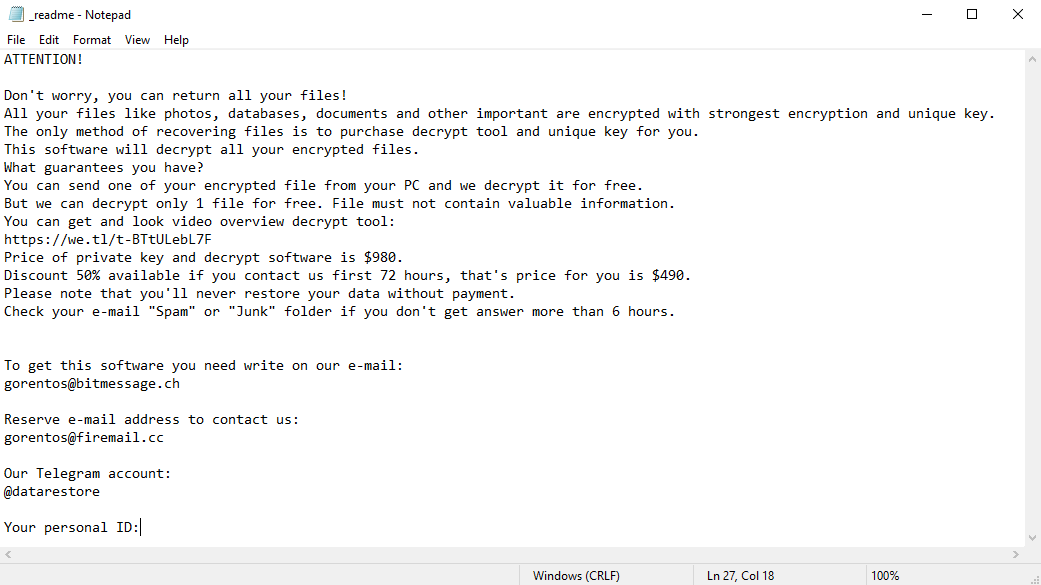
The scary alert demanding from users to pay the ransom to decrypt the encoded data contains these frustrating warnings
The cryptography algorithm used by Mpaj is AES-256. So, if your files got encrypted with a specific decryption key, which is totally distinct and there are no other copies. The sad reality is that it is impossible to restore the information without the unique key available.
In case if Mpaj worked in online mode, it is impossible for you to gain access to the AES-256 key. It is stored on a remote server owned by the frauds who distribute the Mpaj virus.
For receiving decryption key the payment should be $980. To obtain the payment details the victims are encouraged by the message to contact the frauds by email ([email protected]), or via Telegram.
Do not pay for Mpaj!
Please, try to use the available backups, or Decrypter tool
_readme.txt file also indicates that the computer owners must get in touch with the Mpaj representatives during 72 hours starting from the moment of files where encrypted. On the condition of getting in touch within 72 hours, users will be granted a 50% rebate, thus the ransom amount will be minimized down to $490). Yet, stay away from paying the ransom!
I strongly recommend that you do not contact these crooks and do not pay. The one of the most real working solution to recover the lost data – just using the available backups, or use Decrypter tool.
And that’s not just words. Ransomware developers would do everything to force you to pay them. They can try to show you that they are fair-playing, offering to decrypt one or two of your files. Nonetheless, that’s no warranty that croocks will decrypt your files after your payment. No one can force them to do what they promised.
But croocks are usually not so friendly to their victims. The typical conversation with them usually finish with the phrase like “pay us, or we’ll delete all files from your PC”. Also, we have an approved fact that they are collecting all e-mails of their victims to database, that is supposed to be sold in future to another fraudsters, that will spam your e-mail with annoying ads or so.
The peculiarity of all such viruses apply a similar set of actions for generating the unique decryption key to recover the ciphered data.
Ransomware can run the encryption with offline or online key. First type is much easier to decrypt, because it’s usually located on your PC and can be found even manually. Online key is much harder, because it’s stored on ransomware developers’ server. So, an online key may be got only after the federal law interference.
You can check if your files were encrypted with online or offline key. Find a PersonalID.txt in the SystemID folder on your C:\ disk. If this file contains any entity which ends on “t1” – you’ve been encrypted with an offline key, and it could be easily decrypted as soon as this keys will appear in the database of decryptor.
Thus, unless the ransomware is still under the stage of development or possesses some hard-to-track flaws, manually recovering the ciphered data is a thing you can’t really perform. The only solution to prevent the loss of your valuable data is to regularly make backups of your crucial files.
Note that even if you do maintain such backups regularly, they ought to be put into a specific location without loitering, not being connected to your main workstation.
This advice is recomended to follow, because ransomware can counter-act your backups in many ways. The most popular way – it can just inject itself in the backup file, or, if Mpaj ransomware will be “asleep” for a long time, you can accidentaly create a backup with ransomware inside by yourself.
In spite of injecting it’s files in your backups, Mpaj ransomware also able to disable an access to the backups that are created using basic Windows backup creation tools. So, even if you have a backup that surely does not contain ransomware inside, you can just lost an access to them. That’s why it’s recomended to use another backup-creating tools.
And that’s not the only mean action Mpaj ransomware does with your PC. It can also add Microsoft update server into hosts file. Hence, your Windows loses an ability to get the updates, so the operating system is not able to perform “self-cleaning”, wiping out changes that ransomware did in system files and registry.
For instance, the backup may be kept on the USB flash drive or some alternative external hard drive storage. Optionally, you may refer to the help of online (cloud) information storage.
Needless to mention, when you maintain your backup data on your common device, it may be similarly ciphered as well as other data.
For this reason, locating the backup on your main computer is surely not a good idea.
Like all STOP/Djvu ransomware family, Mpaj ransomware has a significant troubles with large files encryption. Videos, archives, 3D models or other files that can easily reach the size of 1+GB are very hard to encrypt. Ransomware can just add it’s .mpaj extension to such files without real encryption, and then left them. You can just delete an .mpaj extension from the file name, and then launch it in common way.
Also, beware of using OneDrive backup methods. It creates a backup in a background mode without any notifications about start of the process, and it literally rewrites your old backup with a new one. So, if you suddenly got a ransomware attack and your OneDrive decides to create a so-called “restore point”, it can rewrite normal files with encrypted one.
How I was infected?
Mpaj has a various methods to built into your system. But it doesn’t really matter what concrete method had place in your case.

Mpaj ransomware attack following a successful phishing attempt.
- hidden installation along with other apps, especially the utilities that work as freeware or shareware;
- dubious link in spam emails leading to the Mpaj installer
- online free hosting resources;
- using illegal peer-to-peer (P2P) resources for downloading pirated software.
There were cases when the Mpaj virus was disguised as some legitimate tool, for example, in the messages demanding to initiate some unwanted software or browser updates. This is typically the way how some online frauds aim to force you into installing the Mpaj ransomware manually, by actually making you directly participate in this process.
Surely, the bogus update alert will not indicate that you are going to actually inject the Mpaj ransomware. This installation will be concealed under some alert mentioning that allegedly you should update Adobe Flash Player or some other dubious program whatsoever.
The common feature of all ransomware, including Mpaj ransomware, is distribution model. In the majority of cases, you will get ransomware in the pack with another malware. Usually, accompaniment malware can be something simple like adware or browser hijackers, as well as keyloggers or trojans. So, if you detect malware on your PC, it would be better you to launch a full scan in your anti-malware software, because even non-critical adware can be a sign of ransomware presence.
The majority of Mpaj ransomware attacks was accompanied by adware activity. A lot of users were complaining about disgusting window with advetiserments, that were opened every hour and after Windows start.
UPD 13.04.2020. Our team got a lot of reports saying that in spite of Mpaj ransomware victims have got a AZORult trojan. That’s a trojan-stealer, which target is your personal data, passwords, credit card numbers and so on.
Another feature that can be used to describe all ransomware is so-called delayed start. You can get Mpaj ransomware on your PC and don’t even notice any signs of it’s presence. Ransomware will start encryption only after command from the command server that is controlled by ransomware distributors. So, users usually notice ransomware presence when it’s too late – their files are encrypted and readme.txt is in every folder.
All STOP/Djvu ransomware family has the same feature. They encrypt only first 150 KB of the file. So, some files that has relatively big size can be run without decryption. I’m talking about MP3, AVI, MP4 or other files. They could be opened, for example, with Winamp, but with one unremovable issue – first seconds would have the silence in spite of sounds or video, because this part of the file is encrypted.
Of course, the cracked apps represent the damage too. Using P2P is both illegal and may result in the injection of serious malware, including the Mpaj ransomware.
Analyzing the statistics, we can conclude that the files from peering networks are one of the most popular sourse of Mpaj ransomware. Software and games that are distributed in such way are usually cracked and distributed in pack with potentially unwanted programs (PUPs) of some sort. But PUPs installation can usually be cancelled, as distinct from ransomware.
The second (by “popularity”) source of Mpaj ransomware are sites which contains an old software that’s already not supported by it’s creators, or old versions of still developing programs. Such software usually distributed as freeware of shareware, offering you to install a lot of attendant software (oftenly – potentially unwanted programs). And that’s no problem for ransomware distributors to pay this sites, offering them to post a software with ransomware inside.
To sum up, what can you do to avoid the injection of the Mpaj ransomware into your device? Even though there is no 100% guarantee to prevent your PC from getting damaged, there are certain tips I want to give you to prevent the Mpaj penetration. You must be cautious while installing free software today.
Make sure you always read what the installers offer in addition to the main free program. Stay away from opening dubious email attachments. Do not open files from the unknown addressees. Of course, your current security program must be always updated.
The malware does not speak openly about itself. It will not be mentioned in the list of your available programs. However, it will be masked under some malicious process running regularly in the background, starting from the moment when you launch your computer.
Mpaj ransomware also adds itself to the RunOnce key in the Windows registry. So, the user can detect it’s presence on his PC via registry checking, but it can be too late, because ransomware edits registry key only after it started encryption process. This prevents any ability to cancel encryption without using a safe mode start, or start with command line support, that can disable any software start in spite of Windows proprietary software.
In spite of adding it’s own .exe file in the RunOnce key, Mpaj ransomware can also add there a readme.txt file that will be shown to user every time he launches his PC. It can be used by ransomware developers as a “reminder”, but also as a notification about successfull encryption of his data, if he wasn’t spotted .mpaj extensions on his files.
The message by the Mpaj ransomware states the following frustrating information:
ATTENTION! Don't worry, you can return all your files! All your files like photos, databases, documents and other important are encrypted with strongest encryption and unique key. The only method of recovering files is to purchase decrypt tool and unique key for you. This software will decrypt all your encrypted files. What guarantees you have? You can send one of your encrypted file from your PC and we decrypt it for free. But we can decrypt only 1 file for free. File must not contain valuable information. You can get and look video overview decrypt tool: https://we.tl/t-9o703iSIHn Price of private key and decrypt software is $980. Discount 50% available if you contact us first 72 hours, that's price for you is $490. Please note that you'll never restore your data without payment. Check your e-mail "Spam" or "Junk" folder if you don't get answer more than 6 hours. To get this software you need write on our e-mail: [email protected] Reserve e-mail address to contact us: [email protected] Your personal ID: Your personal ID: XXXXXXXXXXXXXXXXXXXXXXXXXXXXXXX
The image below gives a clear vision of how the files with “.mpaj” extension look like:
How to remove Mpaj virus?
In addition to encode a victim’s files, the Mpaj infection has also started to install the Azorult Spyware on computer to steal account credentials, cryptocurrency wallets, desktop files, and more.
Reasons why I would recommend GridinSoft6
The is an excellent way to deal with recognizing and removing threats – using Gridinsoft Anti-Malware. This program will scan your PC, find and neutralize all suspicious processes7.
Download Removal Tool.
You can download GridinSoft Anti-Malware by clicking the button below:
Run the setup file.
When setup file has finished downloading, double-click on the setup-antimalware-fix.exe file to install GridinSoft Anti-Malware on your system.

An User Account Control asking you about to allow GridinSoft Anti-Malware to make changes to your device. So, you should click “Yes” to continue with the installation.

Press “Install” button.

Once installed, Anti-Malware will automatically run.

Wait for the Anti-Malware scan to complete.
GridinSoft Anti-Malware will automatically start scanning your system for Mpaj infections and other malicious programs. This process can take a 20-30 minutes, so I suggest you periodically check on the status of the scan process.

Click on “Clean Now”.
When the scan has finished, you will see the list of infections that GridinSoft Anti-Malware has detected. To remove them click on the “Clean Now” button in right corner.

How to decrypt .mpaj files?
Restore solution for big “.mpaj files“
Try removing .mpaj extension on a few BIG files and opening them. Either the Mpaj ransomware read and did not encrypt the file, or it bugged and did not add the filemarker. If your files are very large (2GB+), the latter is most likely. Please, let me know in comments if that will work for you.
The newest extensions released around the end of August 2019 after the criminals made changes. This includes Jope, Mado, Opqz, etc.
As a result of the changes made by the criminals, STOPDecrypter is no longer supported. Tt has been removed and replaced with the Emsisoft Decryptor for STOP Djvu Ransomware developed by Emsisoft and Michael Gillespie.
You can download free decryption tool here: Decryptor for STOP Djvu.
Download and run decryption tool.
Start downloading the decryption tool.
Make sure to launch the decryption utility as an administrator. You need to agree with the license terms that will come up. For this purpose, click on the “Yes” button:
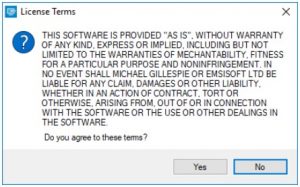
As soon as you accept the license terms, the main decryptor user interface comes up:
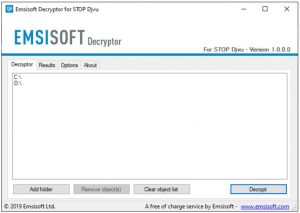
Select folders for decryption.
Based on the default settings, the decryptor will automatically populate the available locations in order to decrypt the currently available drives (the connected ones), including the network drives. Extra (optional) locations can be selected with the help of the “Add” button.
Decryptors normally suggest several options considering the specific malware family. The currently possible options are presented in the Options tab and can be activated or deactivated there. You may locate a detailed list of the currently active Options below.
Click on the “Decrypt” button.
As soon as yo add all the desired locations for decryption into the list, click on the “Decrypt” button in order to initiate the decryption procedure.
Note that the main screen may turn you to a status view, letting you know of the active process and the decryption statistics of your data:
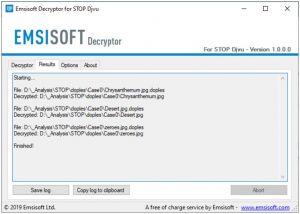
The decryptor will notify you as soon as the decryption procedure is completed. If you need the report for your personal papers, you can save it by choosing the “Save log” button. Note that it is also possible to copy it directly to your clipboard and to paste it into emails or forum messages if you need to do so.
Frequently Asked Questions
How can I open “.mpaj” files?
mpaj files contain important information. How can I decrypt them urgently?
If not, then you can try to restore them through the system function – Restore Point.
All other methods will require patience.
You have advised using GridinSoft Anti-Malware to remove Mpaj. Does this mean that the program will delete my encrypted files?
You need GridinSoft Anti-Malware to remove active system infections. The virus that encrypted your files is most likely still active and periodically,
runs a test for the ability to encrypt even more files. In addition, these viruses install keyloggers and backdoors for further malicious actions
(example theft of passwords, credit cards) often.
Decrytor did not decrypt all my files, or not all of them were decrypted. What should I do?
We will keep you posted on when new Mpaj keys, or new decryption programs appear.
What can I do right now?
- In the United States: On Guard Online;
- In Canada: Canadian Anti-Fraud Centre;
- In the United Kingdom: Action Fraud;
- In Australia: SCAMwatch;
- In New Zealand: Consumer Affairs Scams;
- In France: Agence nationale de la sécurité des systèmes d’information;
- In Germany: Bundesamt für Sicherheit in der Informationstechnik;
- In Ireland: An Garda Síochána;
Video Guide
It’s my favorite video tutorial: How to use GridinSoft Anti-Malware and Emsisoft Decryptor for fix ransomware infections.
If the guide doesn’t help you to remove Mpaj infection, please download the GridinSoft Anti-Malware that I recommended. Also, you can always ask me in the comments for getting help. Good luck!
User Review
( votes)References
- Ransomware-type infection: https://en.wikipedia.org/wiki/Ransomware
- Twitter: https://twitter.com/demonslay335
- My files are encrypted by ransomware, what should I do now?
- About DJVU (STOP) Ransomware.
- Encyclopedia of threats.
- GridinSoft Anti-Malware Review from HowToFix site: https://howtofix.guide/gridinsoft-anti-malware/
- More information about GridinSoft products: https://gridinsoft.com/comparison


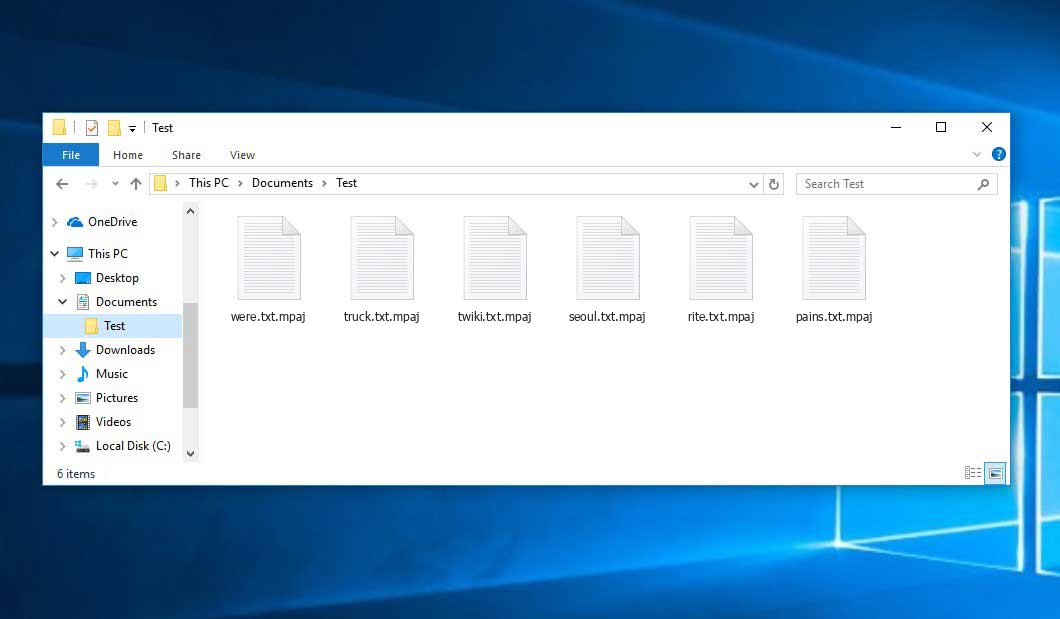
same , it doesn’t for me too please provide me a .MPAJ file decryptor.
I have the same proble also and the decryptor showed “ID appears to be an online ID, decryption is impossible”
is this Worth it?
Hi. Unfortunately, yesterday my computer was infected with a new form of the .MPAJ virus. Like a colleague who wrote here recently. The virus infected several video files on disk “D”. Files on drive “C” remained unchanged. Emsisoft decryption program did not cope with the challenge.
From readme:
ATTENTION!
Don’t worry, you can return all your files!
All your files like photos, databases, documents and other important are encrypted with strongest encryption and unique key.
The only method of recovering files is to purchase decrypt tool and unique key for you.
This software will decrypt all your encrypted files.
What guarantees you have?
You can send one of your encrypted file from your PC and we decrypt it for free.
But we can decrypt only 1 file for free. File must not contain valuable information.
You can get and look video overview decrypt tool:
https://we.tl/t-9o703iSIHn
Price of private key and decrypt software is $980.
Discount 50% available if you contact us first 72 hours, that’s price for you is $490.
Please note that you’ll never restore your data without payment.
Check your e-mail “Spam” or “Junk” folder if you don’t get answer more than 6 hours.
To get this software you need write on our e-mail:
[email protected]
Reserve e-mail address to contact us:
[email protected]
Your personal ID:
0219OIWojlj48fq9aiGods46smJ1FQVxA4baeqB9Y9CfTeQF4o6qT
PersonalID from disc C: fq9aiGods46smJ1FQVxA4baeqB9Y9CfTeQF4o6qT
Message from “Emsisoft Decryptor from STOP Djvu”:
File: C: \ Program Files (x86) \ showteatr.mpaj
No key for New Variant online ID: fq9aiGods46smJ1FQVxA4baeqB9Y9CfTeQF4o6qT
Notice: this ID appears to be an online ID, decryption is impossible
From what I’ve read, my key is online, the “.MPAJ” infection is new… and there is no chance of data recovery. What do you think, will there be a chance in the future? To be honest, I am depressed by this situation and already very tired of all attempts to recover video files.
Hi, thanks for your valuable suggestions. I have tried all these and unable to decrypt my files because it was an online version. Lastly I copied some of my most important files with Mpaj extensions and stored them in a removable disk and following that I have formatted all my hard drive.
yeah i got the same one i formated my pc save dthe files scaned for virus with malwarebytes premium it removed a ton of viruses searched full scan for 1.5m files it found more quarantined them all and delete them , the last hope i have to see if my programer can recover my work for the program i work with , he doesnt have a backup of mine but at least , he says that he might and pretty sure becouse it has happand before if he somehow does decrypt the files i will post again maybe help you guys too , thanks and i feel sorry for all of you , and lets stop downloading shit from insecure files guys it will stop sprrading more , so no keygens no windows loaders no kids games online free shit scam nothing like that i got baited by a fake roblox game installer for my nephew and clicked yes suddenly icons started dissapearing and explorer stoped responding thats when i knew i fucked up … i lost a ton of work just wish my work at least comes back… curse these hackers day and night..
hello dear, can u help me how to restore u Mpaj extensions files
any solution for mpaj files
easily decrypt
How??